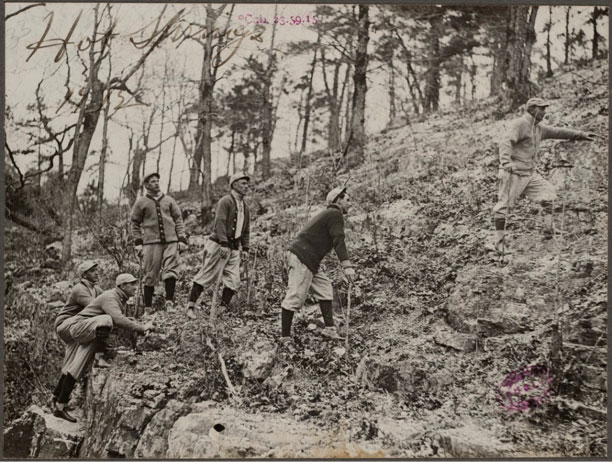The annual rite of spring — Spring Training — is upon us. The exhibition baseball season opened up this past weekend in Florida and Arizona. Like the game of baseball itself, spring training has a very rich and colorful history full of great stories.
Very quickly after organized professional baseball began in the 1870s, teams recognized that preparing for its season in late winter or early spring was especially challenging given that most teams were in the north at that time. In 1886, A.G. Spalding — owner of the Chicago White Stockings (who would later become the Chicago Cubs) — and his player-manager, Adrian “Cap” Anson, acted upon an idea to take their team down to Hot Springs, Arkansas to prepare for the upcoming baseball season (the photo below shows members of the 1912 Boston Red Sox team taking a “Spring Training Hike” in Hot Springs, Arkansas). They thought the hot springs had the right recuperative effect to help their players prepare for the long, grueling season ahead. When the White Stockings won the championship that year, other teams quickly became interested in the same preseason preparation and soon other Major League teams, as well as some Minor League and even Negro League teams, joined the party both on the fields and in the nightlife that the city offered. Voila! Spring training was born. The early camps were specifically made to get players in shape as players typically had other jobs during the off season back then. It wasn’t until about 1910 when teams began marketing the spring ritual to their fans.
 In the years that followed, many things changed and evolved about spring training, here is just a few of the interesting tidbits about it…
In the years that followed, many things changed and evolved about spring training, here is just a few of the interesting tidbits about it…
- While spring training had its start in Arkansas, it eventually settled into Florida in 1913 and the southwest United States because of better weather and space for facilities. But early training cities included such places as Tulsa, New Orleans, Phoenix, San Diego, West Palm Beach, Honolulu, and Jacksonville.
- In 1918, a 23-year-old Babe Ruth hit one of the longest home runs in baseball history in Hot Springs at Whittington Park. The ball soared out of the park and into a pond of alligators at the Arkansas Alligator Farm across the street. The alligator farm is still in operation to this date! In 2011 it was measured that the ball had traveled 573 feet.
- Some of the more unusual cities teams trained over the years include the Brooklyn Dodgers training in Havana, Cuba in 1947 and ’49, and the Dominican Republic in 1948. The Yankees also used those locations in ’50s. The Cubs trained on Catalina Island in the 1920s, ’30s and 40s. Puerto Rico and several northern Mexican cities were also visited by Major League teams in the 1950s and ’60s.
- The “Grapefruit League” got its name from an event that occurred on March 15, 1915. The Brooklyn Dodgers hired a local aviator to fly over the stadium in a pregame stunt where a baseball would be dropped from 500 feet in the air to be caught by the Dodgers’ Hall of Fame manager Wilbert Robinson. The aviator forgot to take a ball up in the plane with them so when it came time to make the drop, all they found in the plane was a grapefruit… you see where this is going. The grapefruit hit Rogers in the chest sending him to the ground with red grapefruit juice and pulp all over him. Legend has it that one of his players, Casey Stengel, said after the event that “Uncle Robbie couldn’t cut it in the Grapefruit League” — and the rest, as they say, is history…
- The “Cactus League” was formed in the desert southwest because of the racial intolerance in the south in the 1940s. Bill Veeck saw the intolerance first hand when attending a game where the minor league team he owned at the time was playing a game in Ocala, FL. He sat in the seating section reserved strictly for blacks, as whites and blacks were not allowed to sit together at the time. He was enjoying their company when a sheriff asked him to leave the section, he refused and eventually threatened the mayor of Ocala about the event. Later on Veeck purchased the Cleveland Indians and, knowing full well that he was about to sign a black player, moved his team’s spring training to Phoenix because of the prior incident in Ocala as well as the general intolerance at that time in that part of the country. They were somewhat more tolerant in Arizona and Veeck was successful in coaxing other Major League teams to join him in the desert southwest for spring training.
- During the years the United States fought in World War II, baseball moved their camps north to help conserve resources to be used for the war effort. The commissioner of baseball and the Federal Office of Defense Transportation agreed to push spring training north of the Potomac and Ohio rivers and east of the Mississippi river so that trains could be better used to move troops and war supplies rather than ballplayers. This resulted in teams training closer to their home cities.
Baseball’s history is full of so many interesting stories, and these are just a few related to spring training. For an especially entertaining education about the beginnings of spring training I highly recommend purchasing the DVD, The First Boys of Spring, written and directed by Larry Foley. It’s available online through Amazon, Barnes & Noble, Target, Walmart and other online retailers.
PLAY BALL!



0 Comments